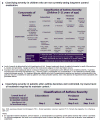Wheezing in children with sickle cell disease
- PMID: 24370489
- PMCID: PMC4167421
- DOI: 10.1097/MOP.0000000000000045
Wheezing in children with sickle cell disease
Abstract
Purpose of review: The purpose of this article is to provide a comprehensive review of wheezing in sickle cell disease (SCD), including epidemiology, pathophysiology, associations between wheezing and SCD morbidity and finally the clinical approach to evaluation and management of individuals with SCD who wheeze.
Recent findings: Wheezing is common in SCD and in some individuals represents an intrinsic component of SCD-related lung disease rather than asthma. Emerging data suggest that, regardless of the cause, individuals with SCD and with recurrent wheezing are at increased risk for subsequent morbidity and premature mortality. We believe individuals who acutely wheeze and have respiratory symptoms should be managed with a beta agonist and short-term treatment of oral steroids, typically less than 3 days to attenuate rebound vaso-occlusive disease. For those who wheeze and have a history or examination associated with atopy, we consider asthma treatment and monitoring per National Heart, Lung and Blood Institute asthma guidelines.
Summary: Wheezing in SCD should be treated aggressively both in the acute setting and with controller medications. Prospective SCD-specific clinical trials will be necessary to address whether anti-inflammatory asthma therapies (leukotriene antagonists, inhaled corticosteroids) can safely mitigate the sequelae of wheezing in SCD.
Conflict of interest statement
Conflicts of Interest:
The authors have no conflicts of interest to report.
Figures




References
-
- Murray JF, Mason RJ. Murray and Nadel’s textbook of respiratory medicine. 5. Philadelphia: Saunders/Elsevier; 2010.
-
- Hassell KL. Population estimates of sickle cell disease in the U.S. Am J Prev Med. 2010 Apr;38(4 Suppl):S512–521. - PubMed
-
- Jaiyesimi O, Kasem M. Acute chest syndrome in Omani children with sickle cell disease: epidemiology and clinical profile. Ann Trop Paediatr. 2007 Sep;27(3):193–199. - PubMed
-
- Crawford MW, Speakman M, Carver ED, Kim PC. Acute chest syndrome shows a predilection for basal lung regions on the side of upper abdominal surgery. Can J Anaesth. 2004 Aug-Sep;51(7):707–711. - PubMed
Publication types
MeSH terms
Substances
Grants and funding
LinkOut - more resources
Full Text Sources
Other Literature Sources
Medical
Research Materials

